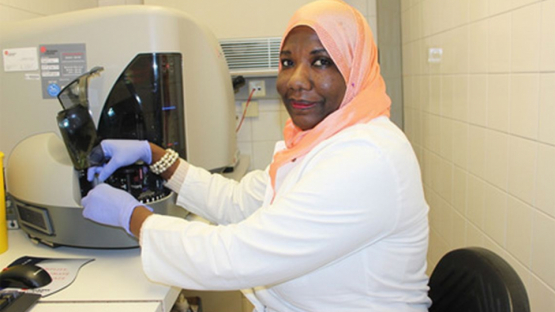
If you would like to learn more about the IAEA’s work, sign up for our weekly updates containing our most important news, multimedia and more.
IAEA Assists Sudan in the Control of Animal Diseases through the Development of Vaccines
"Our national Brucellosis disease control programme is about 70% operational. The fellowship at the IAEA provided me with the opportunity to be trained for the first time on flow cytometry, which will greatly move our programme forward."
Mihad Fath El Rahman Mahmoud Alawad, Veterinarian and Microbiologist, Veterinary Research Institute Khartoum, Sudan
Control and eradication of animal diseases are crucial for food security and improving the livelihoods of farmers.
With support from the Animal Production and Health Subprogramme of the Joint FAO/IAEA Programme of Nuclear Techniques in Food and Agriculture, the IAEA, in partnership with FAO, is assisting Sudan in developing an irradiated vaccine to protect livestock against one such zoonotic disease, Brucellosis.
Mihad Fath El Rahman Mahmoud Alawad works as veterinarian and microbiologist at the Veterinary Research Institute in Khartoum, Sudan. For the past weeks, she has been receiving training at the FAO/IAEA Animal Production and Health Laboratory in Seibersdorf, Austria, where she focused on the measurement of an animal's immune response after vaccination with the aim of producing and standardizing the irradiated Brucella bacteria as a vaccine for sheep. She is the first scientific fellow to be trained with the recently installed flow cytometer, which was procured using extrabudgetary funds contributed by the Government of Germany to the Renovation of the Nuclear Applications Laboratories (ReNuAL) project.*
Brucellosis, also known as Malta fever or Bang's disease, is considered to be one of the major animal diseases in Sudan: Livestock suffer from late term abortions, male infertility and reduced milk production. It can also be transmitted to humans through the consumption of unpasteurized milk or milk products and direct contact with animal secretions. In humans, the disease causes fever, joint and muscle pain, which may result in serious health complications. "Current protection measures involve the slaughtering of infected animals, which is very costly," Alawad explained. Vaccination is therefore the most cost-effective tool for the control and prevention of this disease.
"Irradiating vaccines with gamma rays damages the Brucella bacteria to such an extent that they cannot replicate further, but still maintain their metabolic activities," explained Ivancho Naletoski, Technical Officer in the Animal Production and Health Subprogramme. "In that way, these biologically active but replicating inactive bacteria are not able to cause an infection and will die out, while having a strong immunogenic effect mimicking a live Brucella infection." Moreover, the irradiated vaccine is expected not only to protect livestock from Brucellosis, but also to minimize the chances of exposure of the human population to the currently used live attenuated Brucella vaccine. A live attenuated vaccine is one in which the pathogen is treated to reduce its virulence (i.e., not causing any disease or causing only a mild form of the disease), while keeping it viable, or "live", so that it can generate a desired protective immunological response.
The recently installed flow cytometer helps scientists to develop or formulate better vaccines by enabling them to examine the vaccinated host's immune cells and their respective responses to a disease-causing pathogen. "The flow cytometer can provide important information about the status of cells of the immune system in a highly efficient and accurate manner compared to traditional methods," said Alawad. "With the arrival of the flow cytometer we have been able to increase the scope and application of our animal vaccine research at the Seibersdorf laboratories, and to build Member State capacities," said Viskam Wijewardana, Animal Health Officer at the Animal Production and Health Laboratory.
Alawad's training is part of a technical cooperation project supported by the Animal Production and Health Subprogramme and forms part of an effective Brucella vaccination programme in her country, where Alawad will start a Brucella irradiated vaccine trial on 60 sheep.
For more information: A Need for ReNuAL | IAEA
*The ReNuAL project started in 2014 with the objective of beginning a modernization of the IAEA's nuclear applications laboratories in Seibersdorf, Vienna. With the construction of new laboratory buildings and infrastructure and some upgrading of equipment, the ReNuAL project will establish a strong foundation for the development of fully fit-for-purpose and modern laboratories, capable of responding to Member States' development needs for the next 15-20 years.


